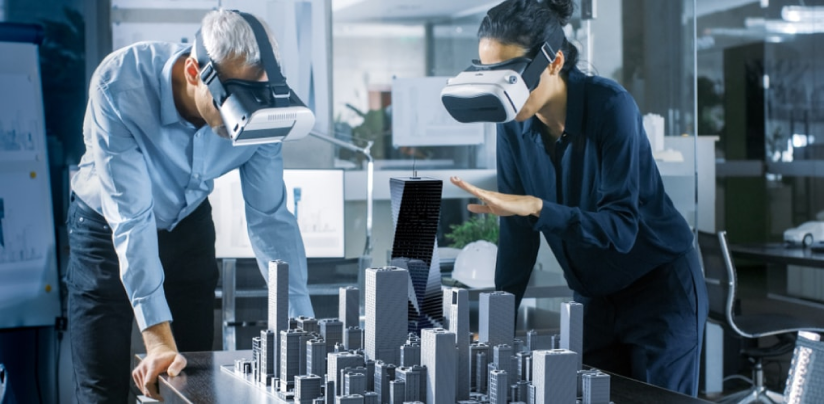In 2019, a lot of the most prominent discussion about the current state of virtual reality as a consumer product has been focussed around gamers. That’s understandable: it’s been a busy period for VR companies and products in the home entertainment space.
Numerous notable additions have been made over the past 12 months to a growing lineup of hardware options for new adopters and existing users alike. Customers wanting to play around with this ever-more-accessible technology on their living room PCs and consoles now have fewer barriers to entry – in terms of both cost and required space – than ever before. Most recently this year, we saw the launch of impressive new headsets in the Valve Index and Oculus Rift S, both of which were immediately flagged by reviewers as significant forward steps for the VR gaming community.
Popular offerings from previous generations – including the PlayStation VR kit (2016), HTC Vive Pro (2018) and the Pimax 4K (2017) – continue to enjoy a steady stream of compatible title development, with the overall implementation of VR in game worlds seemingly improving with each major new release. Still, the jury remains very much out on whether or not VR will indeed prove to be the future of gaming, or is ultimately destined to be something of a niche luxury for the enthusiast market.
What’s arguably more interesting about the snowballing accessibility of all this tech, though, is its booming potential to help drive the growing adoption of VR content for business.
1
4 growing uses of VR in the workplace
Naturally, debate around what the broader future of VR might look like tends to involve some fairly wild speculation, with forecasts ranging from the relatively mundane to the downright fantastical.
A recent infographic from hardware supplier RS Components compiled some common roadmap predictions from a variety of media sources. Starting with Sony’s published goal of shipping more than 2 million consumer headsets to gamers by the end of this financial year, it goes on to flag up several intriguing possibilities for both the near and slightly more distant future of VR as a key driver of 21st-century industry.

2
Teamwork
Notably, the imminent likelihood of VR and AR (augmented reality) apps becoming more closely interwoven is often highlighted, and this could well prove an important factor in speeding up wider workplace integration over the coming years. To date, augmented reality apps have often seen as a more natural fit for collaborative or group sessions, since they don’t require users to be isolated from one another by headsets and other wearables in order to deliver an effective experience. However, a growing number of companies are currently working on building inherently more social virtual reality experiences (Facebook, in particular, hopes to pioneer the social aspects of VR interaction through ongoing expansion of its Spaces app).
With the hardware and programming behind VR already starting to enable more direct social interaction between users, it’s likely to become a much more powerful tool for teamwork exercises and other group sessions in the workplace. As it does, the deeper level of immersion and the convincingly constructed environments possible within VR will expand the possibilities of many team-based activities – such as product demonstrations or troubleshooting sessions – to an enormous degree.

3
Remote working
This relates fairly closely to the teamwork aspects of VR, although in many ways it benefits employees at the opposite end of that scale – namely those logging on to work from locations other than a central office or industrial hub. Over the past decade or so, many sectors have embraced the concept of allowing individual staff members more flexibility in terms of their day-to-day location: it can be a huge benefit to both employers and employees alike, and allows businesses to cast their hiring net far wider in search of the very best candidate for a given role.
VR technologies will undoubtedly prove highly influential in this area over the coming years, as the percentage of employees requesting some degree of remote working continues to increase. Moreover, it will also be used to drive down certain key expenses significantly in areas such as 24/7 customer service, reducing the need to keep costly physical locations like offices and call centre facilities running during periods of reduced demand.
4
Training
There are many obvious benefits to using VR in a training environment. The immersive nature of the experience can help deliver a far more engaging, hands-on training session with almost any type of scenario or learning material – be it a refreshing way to deliver staff manuals or handbooks, or a specific exercise designed to help with upskilling in specialised areas of work. It’s especially effective for helping to train individuals and groups in a range of ‘what if?’ scenarios – in particular, those which may involve potentially hazardous situations or emergency drills – that would otherwise be too risky or logistically difficult to accurately simulate through other means.
5
Recruitment
A number of companies have already begun exploring VR’s potential to enhance hiring processes in the near future. In particular, recruitment companies tend to highlight emerging possibilities like remote office tours and real-time assessment activities, which can of course be incredibly useful for both prospective candidates and employers alike. Businesses are now increasingly looking to explore the full benefits of these possibilities across all sectors – a fact clearly reflected in the number of talks and sessions addressing the topic at this year’s industry-leading XRDC conference.

6
Data and gamification will drive VR for industry
More than anything else, what’s underpinning the bright future of VR and AR in business is the natural compatibility of such technologies with the vital fields of data analytics and gamification.
The value of being able to effectively collect and interpret meaningful user data – both big and small – is, of course, difficult to overstate for companies in any industry. More widespread VR and AR adoption will inherently lead to a proliferation of interactive, permanently connected smart apps and hardware being brought right into the heart of retail and industrial spaces. The benefits, for those looking to achieve a more detailed understanding of client or staff needs and behaviours, are enormous.
Meanwhile, the increasing gamification of all sorts of user experiences has been flagged for some time now as the next big thing in mobile app development – and, bringing us full circle to the beginning of this blog post, it’s an area in which VR is once again going from strength to strength. For businesses, the global trend towards using game mechanics as key engagement tools in non-gaming contexts dovetails perfectly with progressive adoption of VR and AR across areas as diverse as recruitment, training, sales, customer service and product development.
If game-based mechanics do indeed help drive better outcomes for business, then you can expect these sorts of technologies to be at the forefront of cutting-edge corporate solutions in 2020 and beyond.





